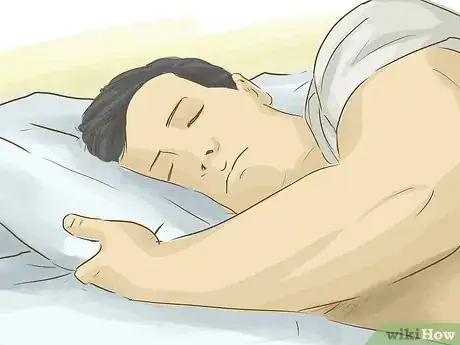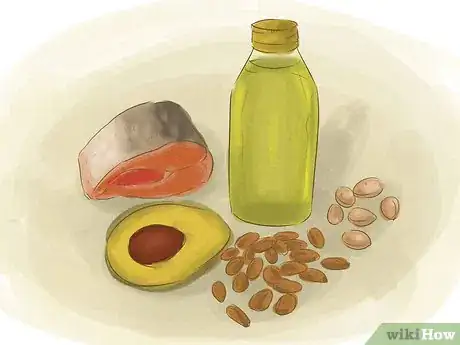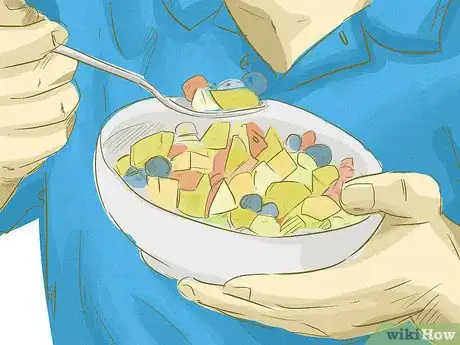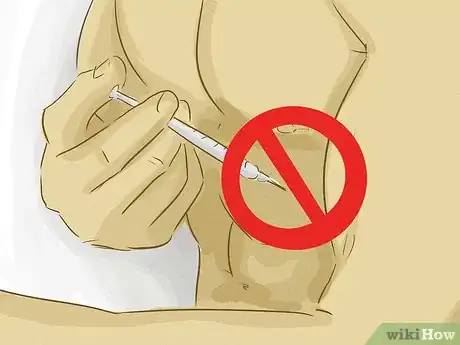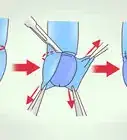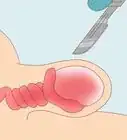This article was co-authored by Brendon Rearick. Brendon Rearick is a Personal Trainer, Strength Coach, Fitness Program Director, and co-founder of Certified Functional Strength Coach (CSFC), a fitness education company in the San Francisco Bay Area. With 17 years of experience in the fitness industry, Brendon specializes in strength and conditioning, and his company CSFC has certified over 3,000 trainers in over 20 countries. Brendon has worked as a Program Director for Mike Boyle Strength and Conditioning (MBSC) and earned his massage therapy license from the Cortiva Institute-Boston. Brendon holds a BS in Kinesiology from the University of Massachusetts Amherst.
There are 15 references cited in this article, which can be found at the bottom of the page.
This article has been viewed 329,573 times.
In a world that's seemingly obsessed with getting as skinny as possible, it's easy to forget that the opposite — getting bigger — can be an equally valid fitness goal. Getting a big, well-muscled body can be a challenging but incredibly rewarding process. By sticking to naturally healthy strategies and remaining patients, it's perfectly possible for almost anyone to get big results in the long term.
Steps
Sample Workout Schedule
The sample workout schedule below should help most people get bigger muscles over several months. For maximum effectiveness, gradually increase the intensity of your routine over time and give your muscles at least one or two rest days per week (you may do cardio exercises on these days if you wish.)
| Exercise | Time/Repetitions | Notes |
|---|---|---|
| Stretches | 10-15 minutes | If desired, substitute yoga or other flexibility-building exercises. |
| Cardio warmup | 5-10 minutes | Jogging, biking, etc. work well. Aim to hit a heart rate of roughly 115 bpm for greater strength while lifting.[1] |
| Barbell Curl | 10-15 repetitions; 3-4 sets | |
| Hammer Curl | 10-15 repetitions; 3-4 sets | |
| Tricep Extensions | 10-15 repetitions; 3-4 sets | |
| Dips | 5-12 repetitions; 3-4 sets | |
| Core exercises | 10-15 minutes; reps will vary | May do crunches, situps, planks, or any other core exercises you see fit |
| Light cardio cooldown | 5 minutes | Fast walking or gentle biking work well. Aim to gradually decrease your elevated heartrate. |
| Exercise | Time/Repetitions | Notes |
|---|---|---|
| Stretches | 10-15 minutes | See above |
| Cardio warmup | 5-10 minutes | See above. |
| Barbell Squat | As many repetitions as you can do safely; 3-4 sets | If using free weights, have a spotter help you. |
| Lying Leg Curl | 10-15 repetitions; 3-4 sets | |
| Leg Press | 10-15 repetitions; 3-4 sets | |
| Calf Raises | As many repetitions as possible; 3-4 sets | |
| Light cardio cooldown | 5 minutes | See above. |
| Exercise | Time/Repetitions | Notes |
|---|---|---|
| Stretches | 10-15 minutes | See above |
| Cardio warmup | 5-10 minutes | See above. |
| Pullup or Pulldown | As many repetitions as you can do safely; 3-4 sets | May use weight-assisted pullup machine if you can't do pullups. |
| Seated Row | 10-15 repetitions; 3-4 sets | |
| Dumbbell Row | As many repetitions as you can do safely; 3-4 sets | |
| Barbell Wrist Curls | 1-2 minutes; 2-3 sets | May use reverse variant. |
| Light cardio cooldown | 5 minutes | See above. |
| Exercise | Time/Repetitions | Notes |
|---|---|---|
| Stretches | 10-15 minutes | See above |
| Cardio warmup | 5-10 minutes | See above. |
| Deadlift | As many repetitions as you can do safely; 3-4 sets | Talk to a staff member at your gym if you don't know how to do a deadlift — improper form can cause injury. |
| Leg Press | 10-15 repetitions; 3-4 sets | |
| Bench Press | As many repetitions as you can do safely; 3-4 sets | Have a spotter present if using heavy free weights. |
| Chest Flies | 10-15; 3-4 sets | |
| Core exercises | 10-15 minutes; reps will vary | May do crunches, situps, planks, or any other core exercises you see fit. |
| Light cardio cooldown | 5 minutes | See above. |
Building Muscle
-
1Aim to work out 4-5 times per week. There's no way around it - getting big takes hard work! If you aren't already working out regularly, try to fit at least four workout sessions into your weekly schedule. You can do even more if you like, as long as you give yourself a chance to rest and recuperate. Your path to bigness starts on your calendar — devote plenty of time to your goal, and you'll see results.
- There's no single "best" workout — what works for one person may not work for another. Many health resources recommend workouts of about 30 minutes to an hour. As long as you stay on task, this should be plenty of time — however, some people prefer longer, less intense workouts.[2]
- The workout schedule above should work for most people. However, it's far from the only workout plan out there. There are a huge variety of workout plans available for free online — all it takes is a simple search engine query to find plenty of good ones.
- To get bigger in a short period of time, you need to lift heavy weights between 8 and 12 reps. If it's getting too heavy, where you can't get 8 done, lighten it up a little bit. And if it's getting too easy where you can do more than 12, increase the weight.[3]
- Focus on full-body exercises that increase hormone response. They increase the utilization of all of your muscles at one time, giving you the most bang for your buck. Some examples include squat, bench deadlift, push-up, single leg squat, single leg deadlifts, wheel rollouts, front plank.[4]
-
2Use resistance training to build muscle. Getting big muscles means spending lots of time doing resistance training. To many people, this basically means "lifting weights." This is a great way to put on muscle, but this isn't actually the only way to do resistance training. For example, bodyweight exercises (like pushups, lunges, and so on) and exercise bands are two other ways to build muscles. Regardless of the exact exercise routine you use, a strong focus on challenging resistance training should lead to muscle growth.
- Traditional weightlifting wisdom is that performing high weight, low rep exercises tend to increase muscle size, while performing low weight, high rep exercises tend to increase muscle tone. However, recent research seems to suggest that as long as you work to the point of fatigue, you should build muscle with either strategy.[5]
Advertisement -
3Be conservative about your cardio training. Cardio training — activities like running, cycling, jogging, swimming, elliptical training, and so on — isn't bad for you. In fact, it's great for you and is known to have many physical and mental health benefits.[6] However, when you're trying to build muscle, putting a heavy focus on cardio can sometimes be like shooting yourself in the foot. Cardio exercise takes lots of time and energy and won't necessarily give you the sorts of big, bulky muscles you're looking for, so the time you spend doing cardio can often be better spent doing resistance training. Aim to spend no more than a day or two per week on cardio training.
- One good way to manage the amount of cardio you do is to reserve cardio for your "off" days — that is, the days when you don't have any resistance training scheduled. This way, you don't waste any time that you would have spent building muscle on cardio.
-
4Join a workout community. Having trouble sticking to your workout routine? Stay motivated by joining a group of people who are also dedicated to their own workouts! Becoming part of a group doesn't just give you people to talk with your struggles, joys, and victories with — it also makes it harder to slack off because your team members will hold you accountable for it![7]
- If you can find people to work out with you in your friends or family, great! If not, consider joining an exercise class at your local gym — it's a great opportunity to meet someone!
- Alternatively, consider getting in touch with an exercise meetup group. These are groups of people who coordinate online to meet at gyms and exercise together. A simple search for "Fitness meetup (your city name)" should yield decent results.
-
5Get plenty of rest. The time you don't spend exercising is just as important as the time you do spend exercising when it comes to building muscle. If you don't give yourself time to rest, your body won't be able to rebuild your muscles as effectively after you break them down through exercise. Remember, building big muscles takes patience, so don't overdo it — give your muscles at least one day a week without exercise.
- In addition, you'll want to make sure to get a full night's sleep after each exercise session. Human growth hormones (the chemicals that help you build muscle) are at their highest levels when you sleep, so neglecting to get a good night's rest after a workout is essentially robbing yourself of muscle gains.[8]
Eating Right
-
1Base your diet around lean protein. Protein is the name of the game when it comes to building muscle — it's what your body uses to construct new, stronger muscle fibers out of your old ones. For this reason, anyone aiming to get big should make sure they're eating enough lean protein. Workout resources generally recommend about 40-60 grams of protein for most adults' meals (more if you are exceptionally large already.)[9]
- For the most muscle-building benefit in the smallest caloric package, try to prioritize lean protein sources. A few examples include:
- White meat chicken
- Leaner cuts of pork and beef
- Beans
- Lentils
- Tofu, soy, etc.
- Egg whites
- Low-fat dairy products
- For the most muscle-building benefit in the smallest caloric package, try to prioritize lean protein sources. A few examples include:
-
2Use whole-wheat carbs for energy. Carbohydrates get a bad rap today, but truthfully they're absolutely vital for a healthy, energetic lifestyle.[10] Whole-wheat carbohydrates provide filling, long-lasting energy that keeps you going throughout the day (including during your workout. Most workout resources recommend eating about 40-80 grams of carbohydrates per meal.[11]
- Carbohydrates made from whole-wheat grains are preferable to those that aren't — whole wheat products incorporate the entire kernel of wheat, which contains more nutrients and protein than "white" breads and the like, which tend to go heavy on sugar. Examples of healthy carbs include:
- Whole wheat breads, pastas, crackers, etc.
- Brown rice
- Quinoa
- Steel-cut or old-fashioned oats
- Beans and legumes
- In addition, most fruits and vegetables qualify as healthy carbohydrates (especially green leafy vegetables) and are rich in vitamins and minerals.
- Carbohydrates made from whole-wheat grains are preferable to those that aren't — whole wheat products incorporate the entire kernel of wheat, which contains more nutrients and protein than "white" breads and the like, which tend to go heavy on sugar. Examples of healthy carbs include:
-
3Enjoy some healthy fats. Contrary to popular belief, "fat" is not a dirty word in the world of fitness. In fact, consuming a small amount of fat each day is a great way to build up a small, healthy reserve of energy (which can be a big help during a tough workout.) It's important, however, to moderate your fat intake — you'll only need about 5-10 grams per meal.[12]
- Some sources of fat are healthier than others. Avoid processed fats, which you'll usually find in snack foods and which tend to lack nutrients. Instead, try one of these healthy fat sources:
- Dairy products
- Nuts
- Avocados
- Most fish (also a good source of protein)
- Eggs
- Some sources of fat are healthier than others. Avoid processed fats, which you'll usually find in snack foods and which tend to lack nutrients. Instead, try one of these healthy fat sources:
-
4Consider taking Supplements. If you know people who take weightlifting seriously, odds are that you've seen them drinking a concoction that looks a little like chocolate milk to get bigger. This is usually a powdered protein supplement like whey, casein or creatine. While these products typically contain more protein than the body would ordinarily need, they can be useful in situations when extra protein is needed, like:[13]
- When starting a new routine
- When exercising very heavily
- When you're growing (i.e., if you're a teenager)
- When recovering from an injury
- When you can't get protein from other sources (i.e., if you're vegan)
- Note, however, that taking lots more protein than you need over a long period of time is not recommended, as it can tax your liver.[14]
Knowing What to Avoid
-
1Don't overtax yourself. If you're looking to get big, working out should be a major part of your life. However, it shouldn't be the only part of your life. Pushing yourself too hard won't just leave you tired, unmotivated, and unhappy — if you don't get enough rest, it will also make it harder for you to put on muscle. Most important of all, several over-exercise can lead to several dangerous health conditions, including:[15]
- Pulled muscles, torn ligaments, etc.
- Joint pain
- Spinal problems
- Very rarely, heart attack, stroke, or aneurysm (if predisposed to these conditions.)
- Rhabdomyolysis (life-threatening; if you experience extreme muscle soreness and dark urine, contact a doctor immediately)
-
2Don't let your eating get out of control. When you start a muscle-building routine, the sudden spike in your energy levels may leave you with an increased appetite, so it may be tempting to simply "pig out" and eat whatever you want. Don't give in — you can increase your caloric intake somewhat, but increasing it too much will leave you with a big surplus of calories that your body will convert to fat. Over a long period of time, this can make you "big," though not in the sense you probably wanted, so try to keep your natural urge to eat more in check.
- In general, you'll feel fullest if you stick to a diet of lean proteins, whole wheat grains, fruits, vegetables, and healthy fats (as recommended above.) On the other hand, processed snacks won't usually "fill you up" in the long term. This means that sticking to a healthy, natural diet will usually keep you from overeating (though it's certainly possible to eat too much of foods that are healthy.
- To keep your eating under control, try using a calorie counting application like the one at MyFitnessPal.com.[16]
-
3Don't result to drugs or steroids. If you desperately want big muscles, it may be tempting at times to use certain illegal shortcuts to reach this goal. Resist this urge. Steroid and other illicit exercise aids may seem to get quick results, but they're not worth the associated health risks, which, depending on the drug, can be quite serious. For example, anabolic steroids are known to cause these health issues:[17]
- High blood pressure
- Increased risk of heart attack and stroke
- Liver disease
- Baldness
- Oily skin and acne
- (In men) lowered sperm count, infertility, shrunken testicles, enlarged breasts
- (In women) increased body hair, enlarged clitoris, deepened voice, shrunken breasts
Expert Q&A
-
QuestionHow should a beginner start working out?
 Ashley Mak, DPTAshley Mak is a Physical Therapist and the Owner of Ashley Mak Performance and Rehabilitation, his physical therapy business based in Hoboken, New Jersey. He is also the CEO of Hudson River Fitness and an Adjunct Professor at Kean University. With over seven years of physical therapy experience, Ashley specializes in both pain management and maximizing physical performance. He received his BA in Biology from Villanova University in 2010 and his Doctorate in Physical Therapy (DPT) from Thomas Jefferson University in 2012.
Ashley Mak, DPTAshley Mak is a Physical Therapist and the Owner of Ashley Mak Performance and Rehabilitation, his physical therapy business based in Hoboken, New Jersey. He is also the CEO of Hudson River Fitness and an Adjunct Professor at Kean University. With over seven years of physical therapy experience, Ashley specializes in both pain management and maximizing physical performance. He received his BA in Biology from Villanova University in 2010 and his Doctorate in Physical Therapy (DPT) from Thomas Jefferson University in 2012.
Physical Therapist When you start to workout with weights, come in expecting that things are going to be awkward at first. Hire a coach to help you get through this because there's so much information that is out there. The reality is that unless you have someone watching you and walking you through and understanding how you move, communicate and learn, you're really doing yourself a disservice and you're going to be spending a lot of time just trying to figure things out on your own. Whereas the coach themselves have the experience and the goals to get you into weightlifting in a faster, more reasonable way because they pretty much have done the work and studied and can implement the necessary strategies for you
When you start to workout with weights, come in expecting that things are going to be awkward at first. Hire a coach to help you get through this because there's so much information that is out there. The reality is that unless you have someone watching you and walking you through and understanding how you move, communicate and learn, you're really doing yourself a disservice and you're going to be spending a lot of time just trying to figure things out on your own. Whereas the coach themselves have the experience and the goals to get you into weightlifting in a faster, more reasonable way because they pretty much have done the work and studied and can implement the necessary strategies for you
Warnings
- Try to avoid working out the same muscle group two days in a row. Instead, switch to a different group. For example, don't work out your chest on Monday and Tuesday — pick one day and exercise another group on the other day.⧼thumbs_response⧽
References
- ↑ http://breakingmuscle.com/strength-conditioning/light-cardio-warm-up-best-before-strength-work
- ↑ http://www.aworkoutroutine.com/how-long-should-my-workout-be/
- ↑ Brendon Rearick. Personal Trainer & Strength Coach. Expert Interview. 30 July 2020.
- ↑ Brendon Rearick. Personal Trainer & Strength Coach. Expert Interview. 30 July 2020.
- ↑ http://www.webmd.com/fitness-exercise/news/20120427/high-reps-with-low-weights-builds-muscle-too
- ↑ http://www.mayoclinic.org/healthy-living/fitness/in-depth/aerobic-exercise/art-20045541
- ↑ http://www.fitday.com/fitness-articles/fitness/weight-loss/5-reasons-why-having-a-workout-partner-can-help-you-achieve-your-goals.html
- ↑ http://www.bodybuilding.com/fun/behar2.htm
- ↑ http://www.muscleandfitness.com/nutrition/meal-plans/build-muscle-stay-lean-meal-plan
- ↑ http://www.hsph.harvard.edu/nutritionsource/carbohydrates/
- ↑ http://www.muscleandfitness.com/nutrition/meal-plans/build-muscle-stay-lean-meal-plan
- ↑ http://www.muscleandfitness.com/nutrition/meal-plans/build-muscle-stay-lean-meal-plan?page=1
- ↑ http://www.webmd.com/vitamins-and-supplements/lifestyle-guide-11/protein-powder
- ↑ http://www.webmd.com/vitamins-and-supplements/lifestyle-guide-11/protein-powder?page=2
- ↑ http://physioworks.com.au/Injuries-Conditions/Activities/weightlifting-injuries
- ↑ http://www.myfitnesspal.com/
- ↑ http://www.webmd.com/men/guide/anabolic-steroid-abuse-topic-overview?page=2
About This Article
If you want to get bigger naturally, aim to work out 4-5 times every week, for 30 minutes to 1 hour each session. Several times a week, focus on resistance training, like lifting weights and performing pushups and lunges. The other days you’re working out, try cardio exercises like running or swimming. You should also eat a diet rich in lean proteins, like chicken, fish, lentils, and egg whites, along with plenty of whole grains, vegetables, and fruits. For tips on avoiding injury due to over-exercising, read on!





